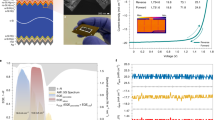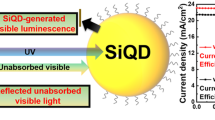Abstract
Traditionally, III–V multi-junction cells have been used in concentrator photovoltaic (CPV) applications, which deliver extremely high efficiencies but have failed to compete with ‘flat-plate’ silicon technologies owing to cost. Here, we assess the feasibility of using metal halide perovskites for CPVs, and we evaluate their device performance and stability under concentrated light. Under simulated sunlight, we achieve a peak efficiency of 23.6% under 14 Suns (that is, 14 times the standard solar irradiance), as compared to 21.1% under 1 Sun, and measure 1.26 V open-circuit voltage under 53 Suns, for a material with a bandgap of 1.63 eV. Importantly, our encapsulated devices maintain over 90% of their original efficiency after 150 h aging under 10 Suns at maximum power point. Our work reveals the potential of perovskite CPVs, and may lead to new PV deployment strategies combining perovskites with low-concentration factor and lower-accuracy solar tracking systems.
This is a preview of subscription content, access via your institution
Access options
Access Nature and 54 other Nature Portfolio journals
Get Nature+, our best-value online-access subscription
$29.99 / 30 days
cancel any time
Subscribe to this journal
Receive 12 digital issues and online access to articles
$119.00 per year
only $9.92 per issue
Buy this article
- Purchase on Springer Link
- Instant access to full article PDF
Prices may be subject to local taxes which are calculated during checkout




Similar content being viewed by others
Change history
13 August 2018
When this Article was originally published, an old version of the associated Supplementary Information file was uploaded. This has now been replaced.
References
More than half of utility-scale solar photovoltaic systems track the sun through the day (US EIA, 2017); https://www.eia.gov/todayinenergy/detail.php?id=30912
Wiesenfarth, M., Philipps, S. P., Bett, A. W., Horowitz, K. & Kurtz, S. Current Status of Concentrator Photovoltaic (CPV) Technology (National Renewable Energy Laboratory, 2017).
Apostoleris, H., Stefancich, M. & Chiesa, M. Tracking-integrated systems for concentrating photovoltaics. Nat. Energy 1, 16018 (2016).
Dahal, R., Li, J., Aryal, K., Lin, J. Y. & Jiang, H. X. InGaN/GaN multiple quantum well concentrator solar cells. Appl. Phys. Lett. 97, 073115 (2010).
Cotal, H. et al. III–V multijunction solar cells for concentrating photovoltaics. Energy Environ. Sci. 2, 174–192 (2009).
Green, M. A. et al. Solar cell efficiency tables (version 50). Prog. Photovolt. Res. Appl. 25, 668–676 (2017).
Tress, W. Perovskite solar cells on the way to their radiative efficiency limit — insights into a success story of high open-circuit voltage and low recombination. Adv. Energy Mater. 7, 1602358 (2017).
Varieras, R. V., Wang, J. & King, D. L. System performance considerations for low-concentration linear-focus silicon-based photovoltaic modules. IEEE J. Photovolt. 3, 1409–1414 (2013).
Kojima, A., Teshima, K., Shirai, Y. & Miyasaka, T. Organometal halide perovskites as visible-light sensitizers for photovoltaic cells. J. Am. Chem. Soc. 131, 6050–6051 (2009).
Lee, M. M., Teuscher, J., Miyasaka, T., Murakami, T. N. & Snaith, H. J. Efficient hybrid solar cells based on meso-superstructured organometal halide perovskites. Science 338, 643–7 (2012).
Kim, H.-S. et al. Lead iodide perovskite sensitized all-solid-state submicron thin film mesoscopic solar cell with efficiency exceeding 9%. Sci. Rep. 2, 591 (2012).
NREL efficiency chart. Available at http://www.nrel.gov/ncpv/images/efficiency_charg.jpg (accessed 16 June 2018).
Yang, W. S. et al. Iodide management in formamidinium-lead-halide–based perovskite layers for efficient solar cells. Science 356, 1376–1379 (2017).
Bush, K. A. et al. 23.6%-efficient monolithic perovskite/silicon tandem solar cells with improved stability. Nat. Energy 2, 17009 (2017).
Duong, T. et al. Rubidium multication perovskite with optimized bandgap for perovskite-silicon tandem with over 26% efficiency. Adv. Energy Mater. 7, 1700228 (2017).
Hörantner, M. T. et al. The potential of multijunction perovskite solar cells. ACS Energy Lett. 2, 2506–2513 (2017).
Zhou, Y. & Gray-Weale, A. A numerical model for charge transport and energy convention of perovskite solar cells. Phys. Chem. Chem. Phys. 18, 4476–4486 (2015).
Adhikari, K. R., Gurung, S., Bhattarai, B. K. & Mari, B. Dependence of perovskite solar cells performance on temperature and solar irradiation. In 3rd Int. Renew. Sustain. Energy Conf. 1–6 (2015); https://doi.org/10.1109/IRSEC.2015.7455146
Leong, W. L. et al. Identifying fundamental limitations in halide perovskite solar cells. Adv. Mater. 28, 2439–2445 (2016).
Law, C. et al. Performance and stability of lead perovskite/TiO2, polymer/PCBM, and dye sensitized solar cells at light intensities up to 70 suns. Adv. Mater. 26, 6268–6273 (2014).
Leijtens, T. et al. Overcoming ultraviolet light instability of sensitized TiO2 with meso-superstructured organometal tri-halide perovskite solar cells. Nat. Commun. 4, 2885 (2013).
Conings, B. et al. Intrinsic thermal instability of methylammonium lead trihalide perovskite. Adv. Energy Mater. 5, 1500477 (2015).
Wang, Z. et al. Efficient and air-stable mixed-cation lead mixed-halide perovskite solar cells with n-doped organic electron extraction layers. Adv. Mater. 29, 1604186 (2017).
Wang, Z. et al. Efficient and ambient-air-stable solar cells with 2D–3D hetero-structured butylammonium–caesium–formamidinium lead halide perovskites. Nat. Energy 2, 17135 (2017).
Lin, Q., Wang, Z., Snaith, H. J., Johnston, M. B. & Herz, L. M. Hybrid perovskites: prospects for concentrator solar cells. Adv. Sci. 5, 1700792 (2018).
Saygili, Y. et al. Planar perovskite solar cells with high open-circuit voltage containing a supramolecular iron complex as hole transport material dopant. ChemPhysChem 19, 1–9 (2018).
Herz, L. M. Charge-carrier mobilities in metal halide perovskites: fundamental mechanisms and limits. ACS Energy Lett. 2, 1539–1548 (2017).
Lee, G. W., Shim, J. I. & Shin, D. S. On the ideality factor of the radiative recombination current in semiconductor light-emitting diodes. Appl. Phys. Lett. 109, 031104 (2016).
Van Reenen, S., Kemerink, M. & Snaith, H. J. Modeling anomalous hysteresis in perovskite solar cells. J. Phys. Chem. Lett. 6, 3808–3814 (2015).
Calado, P. et al. Evidence for ion migration in hybrid perovskite solar cells with minimal hysteresis. Nat. Commun. 7, 13831 (2016).
Calado, P. et al. Identifying dominant recombination mechanisms in perovskite solar cells by measuring the transient ideality factor. Preprint at https://arxiv.org/abs/1804.090491804.09049 (2018).
Tress, W. et al. Interpretation and evolution of open-circuit voltage, recombination, ideality factor and subgap defect states during reversible light-soaking and irreversible degradation of perovskite solar cells. Energy Environ. Sci. 11, 151–165 (2018).
Manor, A., Katz, E. A., Tromholt, T., Hirsh, B. & Krebs, F. Origin of size effect on efficiency of organic photovoltaics. J. Appl. Phys. 109, 074508 (2011).
Tromholt, T., Katz, E. A, Hirsch, B., Vossier, A. & Krebs, F. Effects of concentrated sunlight on organic photovoltaics. Appl. Phys. Lett. 96, 075301 (2010).
Han, X., Qu, J. & Guo, Y. Dependence of silicon concentrator solar cells parameters on temperature and light intensity. Taiyangneng XuebaoActa Energ. Sol. Sin. 36, 1585–1590 (2015).
Hörantner, M. T. & Snaith, H. Predicting and optimising the energy yield of perovskite-on-silicon tandem solar cells under real world conditions. Energy Environ. Sci. 10, 1983–1993 (2017).
Anaraki, E. H. et al. Highly efficient and stable planar perovskite solar cells by solution-processed tin oxide. Energy Environ. Sci. 9, 3128–3134 (2016).
Milot, R. L., Eperon, G. E., Snaith, H. J., Johnston, M. B. & Herz, L. M. Temperature-dependent charge-carrier dynamics in CH3NH3PbI3 perovskite thin films. Adv. Funct. Mater. 25, 6218–6227 (2015).
Rehman, W. et al. Photovoltaic mixed-cation lead mixed-halide perovskites: links between crystallinity, photo-stability and electronic properties. Energy Environ. Sci. 10, 361–369 (2017).
Acknowledgements
This project has received funding from the European Union’s Horizon 2020 research and innovation programme under both grant agreement no. 763977 of the PerTPV project and grant agreement no. 675867 of the INFORM project, and AFOSR through project FA9550-15-1-0115. B.W. acknowledges the European Commission for Marie Skłodowska-Curie actions individual fellowship (REA grant no. 706552-APPEL). We also thank R. Warren and R. Xiang for helping with light intensity measurements and illustrations.
Author information
Authors and Affiliations
Contributions
Z.W., Q.L. and H.J.S. conceived of the project. Z.W. designed the experiments and fabricated the devices and thin film samples. Z.W. performed the thermogravimetric and X-ray diffraction measurements and analysed the data. Q.L. carried out photoluminescence and external quantum efficiency measurements. Z.W. and Q.L. performed light intensity measurements. B.W. and M.G.C. helped with light intensity and four-wire measurements. Y.-H.L. contributed to hole-transporting layer deposition. M.T.K. performed spectral mismatch corrections. L.M.H. and M.B.J. supervised the optical spectroscopy experiments. H.J.S. supervised the whole project. Z.W. wrote the first draft of the paper. All authors discussed the results and contributed to the writing of the paper.
Corresponding author
Ethics declarations
Competing interests
H.J.S. is a co-founder and CSO of Oxford PV Ltd, a company that is commercializing perovskite PV technologies. All other authors declare no competing interests.
Additional information
Publisher’s note: Springer Nature remains neutral with regard to jurisdictional claims in published maps and institutional affiliations.
Supplementary Information
Supplementary Information
Supplementary Figures 1–18, Supplementary Notes 1–6, Supplementary Tables 1–2, Supplementary References
Rights and permissions
About this article
Cite this article
Wang, Z., Lin, Q., Wenger, B. et al. High irradiance performance of metal halide perovskites for concentrator photovoltaics. Nat Energy 3, 855–861 (2018). https://doi.org/10.1038/s41560-018-0220-2
Received:
Accepted:
Published:
Issue Date:
DOI: https://doi.org/10.1038/s41560-018-0220-2
This article is cited by
-
Solar-driven liquid multi-carbon fuel production using a standalone perovskite–BiVO4 artificial leaf
Nature Energy (2023)
-
Long-term operating stability in perovskite photovoltaics
Nature Reviews Materials (2023)
-
Long-range charge carrier mobility in metal halide perovskite thin-films and single crystals via transient photo-conductivity
Nature Communications (2022)
-
A bilayer conducting polymer structure for planar perovskite solar cells with over 1,400 hours operational stability at elevated temperatures
Nature Energy (2021)
-
Crystallization of CsPbBr3 single crystals in water for X-ray detection
Nature Communications (2021)



